Protection of Intellectual Property and Authenticity of Chinese Herbal Medicine Chrysanthe
商务英语阅读(下册)(第二版) unit 10 知 识产权

The key forms of intellectual property are patents, copyrights, trademarks, and trade secrets. Because intellectual property shares many of the characteristics of real and personal property, associated rights permit intellectual property to be treated as an asset that can be bought, sold, licensed, or even given away at no cost.
Patents protect diverse inventions such as industrial designs, manufacturing processes, high-tech products, and molecular compounds.
Many products would not exist without patent protection, especially those that require substantial investments but, once sold, can be easily duplicated by competitors.
Patents, however, are not easily obtained. Patent rights are granted not for vague ideas but for carefully tailored claims. To avoid protecting technology already available, or within easy reach of ordinary artisans, those claims are examined by experts.
知识产权 英文
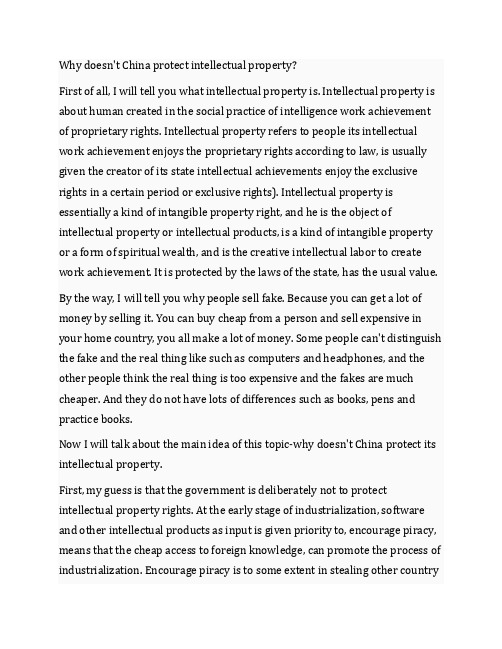
Why doesn't China protect intellectual property?First of all, I will tell you what intellectual property is. Intellectual property is about human created in the social practice of intelligence work achievement of proprietary rights. Intellectual property refers to people its intellectual work achievement enjoys the proprietary rights according to law, is usually given the creator of its state intellectual achievements enjoy the exclusive rights in a certain period or exclusive rights). Intellectual property is essentially a kind of intangible property right, and he is the object of intellectual property or intellectual products, is a kind of intangible property or a form of spiritual wealth, and is the creative intellectual labor to create work achievement. It is protected by the laws of the state, has the usual value. By the way, I will tell you why people sell fake. Because you can get a lot of money by selling it. You can buy cheap from a person and sell expensive in your home country, you all make a lot of money. Some people can't distinguish the fake and the real thing like such as computers and headphones, and the other people think the real thing is too expensive and the fakes are much cheaper. And they do not have lots of differences such as books, pens and practice books.Now I will talk about the main idea of this topic-why doesn't China protect its intellectual property.First, my guess is that the government is deliberately not to protect intellectual property rights. At the early stage of industrialization, software and other intellectual products as input is given priority to, encourage piracy, means that the cheap access to foreign knowledge, can promote the process of industrialization. Encourage piracy is to some extent in stealing other countryknowledge. At least on the earthly operations, such as the country up to 9 into computer to install pirated software, convenient for many people, there are a lot of expensive professional software can be downloaded for free. China's construction industry using pirated software, many computers are worth hundreds of thousands of, not only is the computer price, more is pirated software, makes the industry on the use of the foreign advanced software quickly. The benefit of it, for their own it is positive. BUT they didn't think about the disadvantages about it before. The protection of intellectual property rights is the invention of knowledge. Piracy is hitting them. Yes, foreigners can't earn the Chinese intellectual property money, earn less than Chinese people. Concrete, is the domestic software across the retreat, the majority of publications cannot make money, and even published a paper in the industry also big and copying the wind.Second, intellectual property than other their rights more complicated and more hidden. In China, none of other rights can be very good protection, and the intellectual property rights are much more difficult to protect.(1) A large number of intellectual property rights involved a lot of China, and the number of intellectual property office Co., LTD. From application to authorization is a long time.(2) China Development difference between east and west, south and north, remote areas don't attach importance to intellectual property rights.(3) China's intellectual property rights in the society cannot get positive attention. Because there are infringement occurs.Third, the purchasing power of the people not reached to the point of pressure supports genuine. For example: the domestic ticket, and North America, but can the domestic per capita compare to North America? The answer is obvious.· But now the government has already known the disadvantages of not protecting the intellectual property. They also did a lot of things to protect the intellectual property. But this is not good enough, so what could Chinese government to do to make the situation better, let me tell you the following points that should the government do.In the hand, National copyright administration should assist the national legislation, perfecting the propulsion system. But it is more need to standardize the operators, service providers, and transformation of the mode of regulation and set up a technology platform, from passive to active. In addition, should give full play to their role as the industry association. Through the collective management organization to solve the current situation of the existing peer-to-peer authorization model.In the other hand, countries should popularize knowledge of intellectual property rights, strengthen the consciousness of protection of intellectual property rights. Encourage domestic competitors to develop new technology, to actively to enjoy the benefits of intellectual property protection system, crack down on piracy.。
保护的意义作文英语
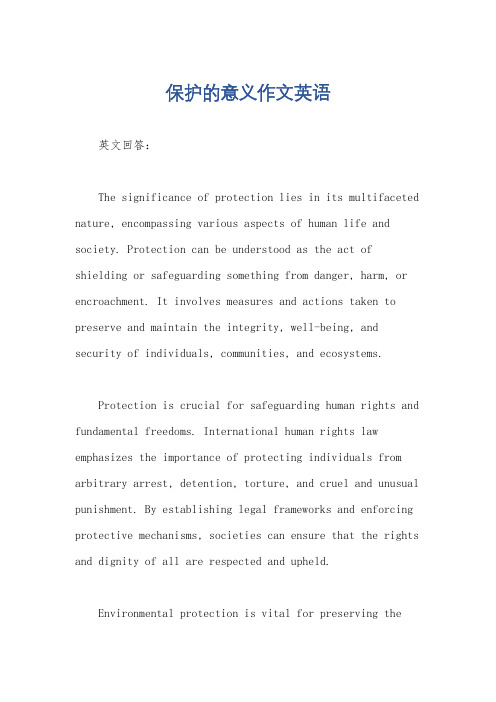
保护的意义作文英语英文回答:The significance of protection lies in its multifaceted nature, encompassing various aspects of human life and society. Protection can be understood as the act of shielding or safeguarding something from danger, harm, or encroachment. It involves measures and actions taken to preserve and maintain the integrity, well-being, and security of individuals, communities, and ecosystems.Protection is crucial for safeguarding human rights and fundamental freedoms. International human rights law emphasizes the importance of protecting individuals from arbitrary arrest, detention, torture, and cruel and unusual punishment. By establishing legal frameworks and enforcing protective mechanisms, societies can ensure that the rights and dignity of all are respected and upheld.Environmental protection is vital for preserving theEarth's ecosystems and resources for generations to come. By implementing measures to reduce pollution, conserve biodiversity, and mitigate climate change, we can protect the health of the planet and ensure its sustainability. Sustainable development practices that balance economic growth with environmental protection are essential in this regard.Economic protection aims to safeguard the financial stability of individuals, businesses, and nations. This can involve measures such as insurance, social safety nets, and trade policies designed to support domestic industries and promote fair competition. By creating a stable economic environment, protection contributes to economic growth and prosperity.Protection in the context of intellectual property rights ensures that creators and innovators are rewardedfor their work and have exclusive rights over their creations. Copyright, patents, and trademarks are legal mechanisms that protect intellectual property and foster creativity and innovation. Without proper protection,individuals and businesses would be less incentivized to invest in new ideas and products.Protecting cultural heritage and traditions isessential for maintaining cultural diversity and preserving the collective memory of societies. This involves safeguarding tangible assets such as historical sites, monuments, and artifacts, as well as intangible assets like languages, customs, and beliefs. Cultural protection ensures that diverse cultures can thrive and be passed on to future generations.Protecting personal data and privacy in the digital age is of paramount importance. With the rise of datacollection and sharing, individuals need to be protected from unlawful use, misuse, or surveillance of their personal information. Data protection regulations and ethical guidelines aim to strike a balance between data sharing and individual privacy rights.In conclusion, the significance of protection lies in its capacity to safeguard human rights, the environment,economic stability, intellectual property, cultural heritage, and personal data. By implementing protective measures and mechanisms, we can foster a world that is just, equitable, sustainable, and respectful of human dignity.中文回答:保护的意义。
自主知识产权的英语
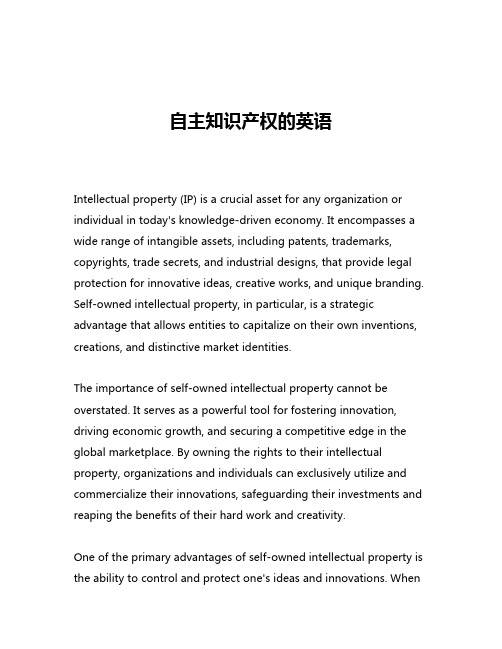
自主知识产权的英语Intellectual property (IP) is a crucial asset for any organization or individual in today's knowledge-driven economy. It encompasses a wide range of intangible assets, including patents, trademarks, copyrights, trade secrets, and industrial designs, that provide legal protection for innovative ideas, creative works, and unique branding. Self-owned intellectual property, in particular, is a strategic advantage that allows entities to capitalize on their own inventions, creations, and distinctive market identities.The importance of self-owned intellectual property cannot be overstated. It serves as a powerful tool for fostering innovation, driving economic growth, and securing a competitive edge in the global marketplace. By owning the rights to their intellectual property, organizations and individuals can exclusively utilize and commercialize their innovations, safeguarding their investments and reaping the benefits of their hard work and creativity.One of the primary advantages of self-owned intellectual property is the ability to control and protect one's ideas and innovations. Whenan entity holds the rights to its IP, it can prevent others from copying, using, or profiting from its creations without permission. This exclusivity allows the IP owner to establish a dominant market position, charge premium prices, and maintain a sustainable competitive advantage.Furthermore, self-owned intellectual property can be leveraged to generate revenue streams through licensing agreements, royalties, or the sale of IP assets. This can provide a valuable source of income and enable the IP owner to reinvest in further research, development, and innovation. By capitalizing on their own intellectual property, organizations and individuals can fund the continuous improvement and expansion of their product or service offerings, ensuring their long-term viability and growth.In addition to financial benefits, self-owned intellectual property can also enhance an entity's reputation and brand recognition. When an organization or individual is known for its unique and innovative products or services, it can establish a strong market presence and cultivate customer loyalty. This, in turn, can lead to increased customer trust, brand loyalty, and market share, further solidifying the entity's position in the industry.Moreover, self-owned intellectual property can serve as a valuable asset for securing funding, attracting investment, and fosteringstrategic partnerships. Investors and potential partners often view strong IP portfolios as a testament to an organization's innovative capabilities, technical expertise, and long-term growth potential. By demonstrating the value and exclusivity of their intellectual property, entities can more effectively attract funding, form collaborative agreements, and expand their reach in the market.However, the protection and management of self-owned intellectual property is not without its challenges. Entities must navigate a complex legal landscape, ensuring that their IP is properly registered, maintained, and enforced against potential infringement. This requires a deep understanding of intellectual property laws, as well as the dedication of resources to monitor and defend their rights.Furthermore, the rapid pace of technological change and the global nature of the modern business environment can make it increasingly difficult to maintain a sustainable competitive advantage based solely on self-owned intellectual property. Organizations must continuously innovate, adapt, and evolve their IP strategies to stay ahead of the curve and respond to emerging market trends and competitive threats.Despite these challenges, the strategic importance of self-owned intellectual property remains undiminished. By effectively leveraging their own innovations, creations, and distinctive market identities,entities can drive innovation, enhance their competitiveness, and secure long-term success in the global marketplace.In conclusion, self-owned intellectual property is a crucial asset that provides organizations and individuals with a powerful competitive advantage. It enables the exclusive utilization and commercialization of innovative ideas, the generation of revenue streams, the enhancement of brand reputation, and the attraction of investment and strategic partnerships. While the protection and management of self-owned IP can be complex, the benefits it offers make it an essential component of any successful business or entrepreneurial endeavor in the modern knowledge-driven economy.。
知识产权倡议书英文作文

知识产权倡议书英文作文《Protecting Intellectual Property Rights: A Call to Action》As the global economy continues to evolve, the protection of intellectual property rights has become increasingly important. In order to foster innovation, creativity, and economic growth, it is crucial that we work together to uphold and safeguard these rights.Intellectual property rights refer to the legal rights that creators and innovators have over their creations, such as inventions, designs, and artistic works. These rights are essential for encouraging individuals and businesses to invest in new ideas, products, and services, as they provide a level of security and assurance that their work will be protected from infringement.Unfortunately, intellectual property rights are often violated, whether through counterfeiting, piracy, or unauthorized use. This not only harms the creators and innovators, but also undermines the economy and innovation ecosystem as a whole. In order to address these challenges, we must take collective action to protect these rights.One of the key ways to protect intellectual property rights is through education and awareness. By increasing public understanding of the importance of intellectual property rights, we can create a culture of respect for creativity and innovation. This includes providing resources and information to individuals, businesses, and policymakers about the value of intellectual property rights, as well as the potential risks and consequences of violation.Furthermore, it is essential to strengthen the legal framework and enforcement mechanisms for protecting intellectual property rights. This involves developing and implementing laws, regulations, and policies that effectively prevent, deter, and penalize infringement. Additionally, it requires the collaboration of law enforcement agencies, judicial systems, and intellectual property offices to ensure that these rights are upheld and respected.In addition, fostering collaboration and cooperation among stakeholders is crucial for the protection of intellectual property rights. This includes building partnerships between governments, businesses, research institutions, and civil society organizations to share best practices, coordinate efforts, and develop innovative solutions. By working together, we can effectively address the challenges and complexities of protecting intellectual property rights in an increasingly globalized and digital world. Ultimately, by protecting intellectual property rights, we can create a conducive environment for innovation, creativity, and economic development. This not only benefits the creators and innovators, but also society as a whole, as it drives progress and prosperity. Therefore, it is imperative that we heed this call to action and prioritize the protection of intellectual property rights. Only through collaboration, education, and commitment can we create a future where intellectual property rights are respected and valued.。
保护知识产权英语作文
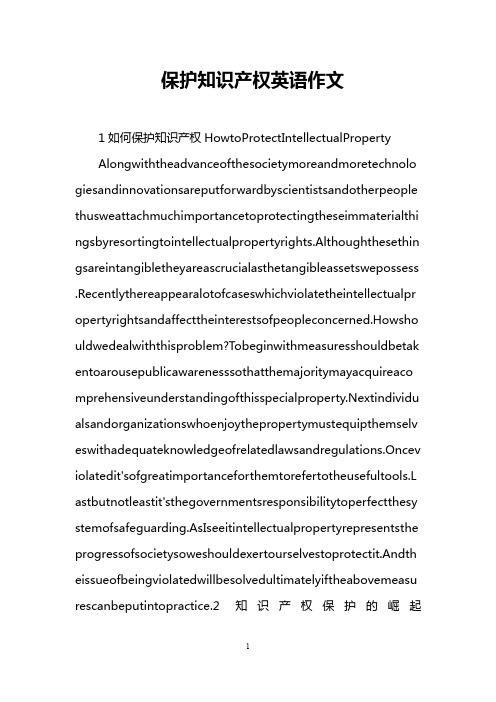
保护知识产权英语作文1如何保护知识产权HowtoProtectIntellectualPropertyAlongwiththeadvanceofthesocietymoreandmoretechnolo giesandinnovationsareputforwardbyscientistsandotherpeople thusweattachmuchimportancetoprotectingtheseimmaterialthi ngsbyresortingtointellectualpropertyrights.Althoughthesethin gsareintangibletheyareascrucialasthetangibleassetswepossess .Recentlythereappearalotofcaseswhichviolatetheintellectualpr opertyrightsandaffecttheinterestsofpeopleconcerned.Howsho uldwedealwiththisproblem?Tobeginwithmeasuresshouldbetak entoarousepublicawarenesssothatthemajoritymayacquireaco mprehensiveunderstandingofthisspecialproperty.Nextindividu alsandorganizationswhoenjoythepropertymustequipthemselv eswithadequateknowledgeofrelatedlawsandregulations.Oncev iolatedit'sofgreatimportanceforthemtorefertotheusefultools.L astbutnotleastit'sthegovernmentsresponsibilitytoperfectthesy stemofsafeguarding.AsIseeitintellectualpropertyrepresentsthe progressofsocietysoweshouldexertourselvestoprotectit.Andth eissueofbeingviolatedwillbesolvedultimatelyiftheabovemeasu rescanbeputintopractice.2知识产权保护的崛起TheRiseofIntellectualPropertyProtectionIntellectualpropertyscarcelyexistedinthevocabulariesofaca demicresearchersandadministratorseven15yearsago.Nowitisa never-presentpartofdiscussionsonresearchpoliciesanddirectio ns.Thisnewimportanceofintellectualpropertyinacademiareflect sachangingviewontheirrelationshipsofresearchatuniversitiesto thesurroundingsociety.Untilrecentlyresearchatuniversitieshasb eenrelativelyisolatedfromdemandsofeconomicutilityandeduca tionofgraduatestudentshasemphasizedacareerinacademicrese archasthefinalgoal.NowalmostallresearchuniversitiesintheUnit edStateshavetechnologylicensingoperations.ThenumberofU.S. patentsgrantedtoAmericanuniversitiesinayearrosefromabout3 00in1980toalmost2000in1995.Thedirecteconomicimpactoftec hnologylicensingontheuniversitiesthemselveshasbeenrelativel ysmall.Incontrasttheimpactofuniversitytechnologytransferont helocalandnationaleconomieshasbeensubstantialandleadstot heconclusionthattheLicensingActisoneofthemostsuccessfulpie cesofeconomicdevelopmentinrecenthistory.Ithasbeenestimate dthatmorethan200000jobshavebeencreatedintheUnitedStates inproductdevelopmentandmanufacturingofproductsfromuniv ersitylicenseswiththenumberincreasingfairlyrapidlyasthelicens esmature.Intellectualpropertytermshavebecomevitallyimportant.Thecompanywantstobeassuredthatitcanusetheresultsofther esearch-andthattheseresultswillnotbeavailabletotheircompetit ors.Butmostuniversitiesinsistthattransferofresearchresultsispiv otaltotheiridentityandmissionandwillnotagreetokeeptheprojec tresultssecret.Thekeytoresolvingthisdilemmaistograntpatents:t heuniversitywillpublishtheresultsbutwillfirstagreetofilepatents thatwillprotectthecompany’sprivilegeinthecommercialmarketplace.3山寨文化的兴起TheRiseofShanzhaiCultureThevastarrayofknockoffname-brandproductssuchascellph onesDVDsMP3playershavemade”shanzhai”thehottestwordoftheyear.Nowwewearshanzhaiwatchestalkthr oughshanzhaicellphonesplayshanzhaivideogamesuseshanzhai computersevenwatchshanzhaiTVshows.onceatermusedbefore someelectronicproductstosuggestacopycatversionofinferiorq ualityshanzhainowsuggeststomanychinesecreativityandtrendi ness.Withthemediaallovertheriseofshanzhaiculturepublicopini onsareclearlydivided.仿冒名牌产品繁多,如手机,DVD,MP3播放器,这些使得“山寨”成了一年中最热的词。
Basic Situation of the Protection of Intellectual Property Rights
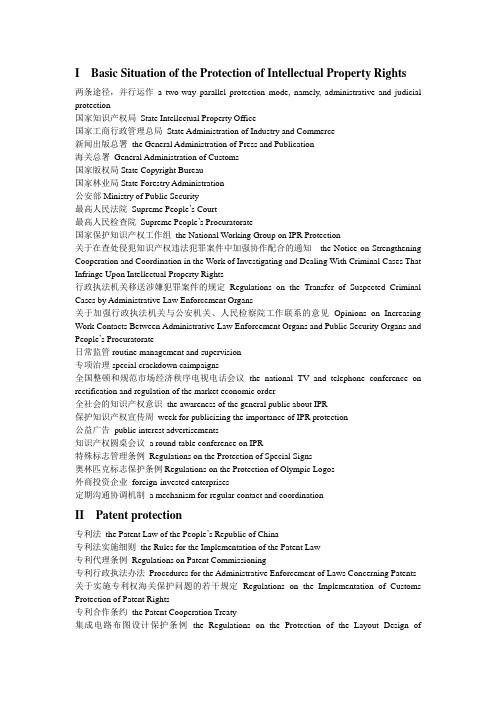
I Basic Situation of the Protection of Intellectual Property Rights两条途径,并行运作 a two-way parallel protection mode, namely, administrative and judicial protection国家知识产权局State Intellectual Property Office国家工商行政管理总局State Administration of Industry and Commerce新闻出版总署the General Administration of Press and Publication海关总署General Administration of Customs国家版权局State Copyright Bureau国家林业局State Forestry Administration公安部Ministry of Public Security最高人民法院Supreme People’s Court最高人民检查院Supreme People’s Procuratorate国家保护知识产权工作组the National Working Group on IPR Protection关于在查处侵犯知识产权违法犯罪案件中加强协作配合的通知the Notice on Strengthening Cooperation and Coordination in the Work of Investigating and Dealing With Criminal Cases That Infringe Upon Intellectual Property Rights行政执法机关移送涉嫌犯罪案件的规定Regulations on the Transfer of Suspected Criminal Cases by Administrative Law Enforcement Organs关于加强行政执法机关与公安机关、人民检察院工作联系的意见Opinions on Increasing Work Contacts Between Administrative Law Enforcement Organs and Public Security Organs and People’s Procuratorate日常监管routine management and supervision专项治理special crackdown caimpaigns全国整顿和规范市场经济秩序电视电话会议the national TV and telephone conference on rectification and regulation of the market economic order全社会的知识产权意识the awareness of the general public about IPR保护知识产权宣传周week for publicizing the importance of IPR protection公益广告public interest advertisements知识产权圆桌会议 a round-table conference on IPR特殊标志管理条例Regulations on the Protection of Special Signs奥林匹克标志保护条例Regulations on the Protection of Olympic Logos外商投资企业foreign-invested enterprises定期沟通协调机制 a mechanism for regular contact and coordinationII Patent protection专利法the Patent Law of the People’s Republic of China专利法实施细则the Rules for the Implementation of the Patent Law专利代理条例Regulations on Patent Commissioning专利行政执法办法Procedures for the Administrative Enforcement of Laws Concerning Patents 关于实施专利权海关保护问题的若干规定Regulations on the Implementation of Customs Protection of Patent Rights专利合作条约the Patent Cooperation Treaty集成电路布图设计保护条例the Regulations on the Protection of the Layout Design ofIntegrated Circuits关于加强知识产权行政执法开展专项执法行动的工作方案the Work Program onStrengthening the Enforcement of the Laws on Intellectual Property Rights and Launching a Special Law Enforcement Campaign专利审查体系patent examination system中国专利局the China Patent Office专利管理机构patent administrative organs专利代理patent commissioning专利技术转让中介intermediary services for patent technology transfer专利技术评估patent technology evaluation专利申请patent application国内申请domestic application国外申请applications from other countries发明专利invention patents实用新型专利utility model patents外观设计专利exterior design patents专利侵权/纠纷案cases involving patent infringement / patent disputes冒充专利案cases of patent counterfeits假冒他人专利案cases of unauthorized use of others’ patentsIII Trademark protection与贸易有关的知识产权协议Agreement on Trade-Related Aspects of Intellectual PropertyRights商标法the Trademark Law商标法实施条例the Regulations for the Implementation of the Trademark Law商标评审规则the Trademark Assessment Rules驰名商标认定和保护规定Provisions on the Recognition and Protection of Well-KnownTrademarks集体商标、证明商标注册和管理办法Procedures for the Management and Registration of Collective Trademarks and Certification Trademarks马德里商标国际注册实施办法Procedures for the Implementation of Madrid Agreement for the International Registration of Trademarks保护工业产权巴黎公约the Paris Convention for the Protection of Industrial Property商标印制管理办法Procedures for the Administration of the Printing of Trademarks商标统一注册the unified registration of trademarks商标注册程序trademark registration procedure商标注册申请applications for trademark registration服务商标service trademarks集体商标collective trademarks证明商标certification trademarks公众熟知的商标trademarks well known to the public立体商标three-dimensional trademarks颜色组合商标colour combination trademarks驰名商标well-known trademarks地理标志geographical marks注册商标专用权the right to exclusive use of registered trademarks消费者的合法权益the legitimate rights and interests of consumers侵权假冒商标标识counterfeiting trademark logos追究刑事责任pursue criminal responsibilities保护知识产权专项行动special campaigns on IPR protection各类商标违法案件law-violation cases involving trademarks商标一般违法案件common violations of trademark laws and regulations商标侵权假冒案件cases involving trademark infringement and counterfeitingIV Copyright protection著作权法the Copyright Law计算机软件保护条例Regulations on the Protection of Computer Software著作权法实施条例Regulations for the Implementation of the Copyright Law著作权行政处罚实施办法Procedures for the Implementation of Administrative Sanctions Concerning Copyright著作权集体管理条例Regulations on the Collective Management of Copyright版权行政管理与行政执法体系the system of copyright administrative management and law enforcement侵权盗版copyright infringement and piracy公安部departments of public security工商部administrative organs for industry and commerce新闻出版departments of press and publication文化部cultural departments版权社会服务体系copyright pubic service system版权集体管理机构copyright collective management organs版权代理机构copyright agencies版权保护协会copyright protection association相关行业协会professional associations权利人组织organizations of copyright holders中华版权代理总公司the Copyright Agency of China中国版权协会Copyright Society of China中国音乐著作权协会the China Copyright Society of Works of Music中国版权保护中心Copyright Protection Center of China中国文联China Federation of Literature and Art Circles中国作家协会Chinese Writers Association中国电影家协会China Film Association版权维权组织copyright protection organizationsV IPR protection for audio and video products一整套音像制品管理制度 a whole set of system for the management of audio and video products保护知识产权制度IPR protection system音像制品经营许可证制度audio and video business license system出版权专有制度exclusive publication right system复制委托书制度duplication authorization system光盘来源识别码制度SID code system进口音像制品内容审查制度censorship system for imported audio and video products奖励举报人制度the system of awards for informants音像制品加贴统一防伪标志制度the system of uniform anti-counterfeit labels for audio andvideo products音像制品仓库登记备案制度the system of registration and filing of audio and video products in storehouses非法音像制品监督举报公示制度the system of inspection of , report on and keeping the public informed of illegal audio and video products音像制品管理条例Regulations on the Administration of Audio and Video Products民法通则the General Principles of the Civil Law刑法Criminal Law音像制品出版管理规定the regulations on the administration of publication of Audio and Video Products音像制品批发、零售、出租管理办法Measures for the Administration of Wholesale, Retail andRenting of Audio and V ideo Products音像制品进口管理办法Measures for the Administration of Import of Audio and Video Products 中外合作音像制品分销企业管理办法Measures for the Administration of China-Foreign Cooperative Distribution Enterprises of Audio and Video Products精简、效能、统一streamlining, efficiency and unification文化市场稽查队伍investigation squads of cultural markets出版物市场监管部门the publication market supervision authorities盗版音像制品/正版pirated audio and video products / original copies吊销复制经营许可证revoke the duplication business license文化市场稽查管理部门cultural market inspecting and management authoritiesVI Protection of New V arieties of Agricultural and Forestry Plants 植物新品种New varieties of plants《植物新品种保护条例》Regulations on the Protection of New V arieties of Plants农业部Ministry of Agriculture国家林业局State Forestry Administration植物新品种保护办公室Office of Protection of New V arieties of Plants植物新品种复审委员会Reexamination Board for New V arieties of Plants农业植物新品种繁殖材料保藏中心Center for the Preservation of Breeding Materials of New V arieties of Agricultural Plants植物新品种测试中心Center for Testing of New V arieties of Plants品种权Plant V ariety Right农业植物新品种保护名录List of Protected New V arieties of Agricultural Plants林业植物新品种保护名录List of Protected New V arieties of Forest Plants《国际植物新品种保护公约》International Convention for the Protection of New V arieties ofPlants品种权申请Applications for plant variety rights大田作物Field crops果树Fruit tress观赏植物Decorative plants木本观赏植物Decorative arbors月季Chinese rose牡丹Peony一品红Christmas flower杜鹃Azalea杨树Poplar板栗Chinese chestnuts杏Apricot桉树Eucalyptus核桃Walnut私人育种者Individuals engaging in breeding农业植物新品种侵权和假冒Cases of infringement upon new agricultural plant variety rights and of faking new agricultural plant varietiesVII Custom Protection of Intellectual Property Rights边境保护Border protection报关单证审核Examination of customs declaration bills and certificates进出口货物查验Inspection of imported and exported goods对侵权货物的扣留和调查Detention and investigation of right- infringing goods对违法进出口人进行处罚Punishment of illegal importer and exporters对侵权货物进项处置Disposal of right infringing goods海关知识产权保护方面的职能The function of IPR customs protection保守商业秘密Keep business secret国际注册商标的备案Filing of international registered trademark担保金的收取和退还Collecting and returning of security deposit权利人对有关费用的承担Payment of relevant fees by the proprietors知识产权海关保护的中央备案制度A central filing system for IPR customs protection口岸海关The port customs核准Confirm假冒和盗版产品Fake and pirated products查获Ferret outVIII Public security organs act on criminal infringement on intellectual property right打击crack down on执法水平law enforcement standards社会主义市场经济socialist market economy刑事诉讼法the Criminal Procedure Law专业侦查队伍specialized investigation team受案、立案、侦查、破获receive, file, investigate, crack (cases)犯罪嫌疑人suspects侵犯商标专用权infringement on the exclusive rights of trademark ownership伪劣产品fake or inferior products定期沟通协调制度 a system of regular communication and coordination跨国跨境侵犯知识产权案件transnational and trans-border criminal cases of IPR infringement 美国国土安全部移民与海关执法局the Immigration and Customs Enforcement of the Department of Homeland Security of the United StatesIX Judicial Protection of Intellectual Property Rights检查机关procuratorial organs侵犯知识产权刑事案件cases of criminal IPR infrigement法律监督legal supervision犯罪嫌疑人people suspected司法程序judicial proceedings技术合同纠纷technological contract dispute审结侵犯刑法分则Specific Provision of the Criminal Law集成电路布图设计integrated circuit layout designs一审案件cases of first instance统一执法尺度make law enforcement standards consistent定罪标准condemnation standards知识产权法官IPR judges职业建设professional training。
大学英语六级卷真题模拟满分答案
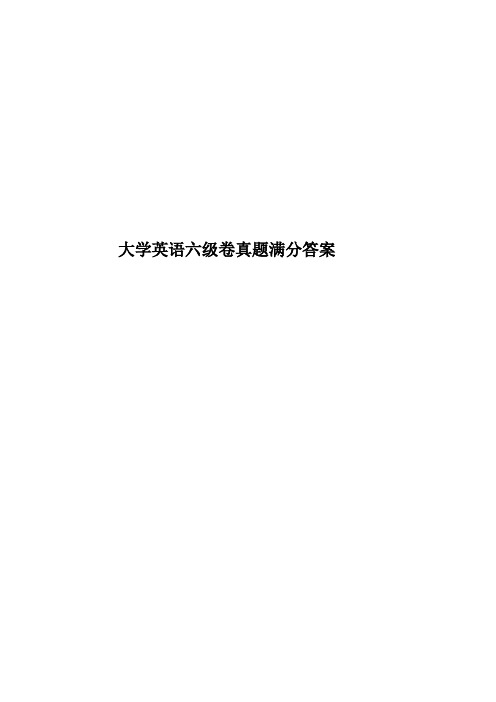
大学英语六级卷真题满分答案12月20日大学英语六级A卷真题满分答案6[1] Part VIndividuals and businesses have legal protection for intellectual property they create and own . intellectual proper _62_from creative thinking and may include products, 63 processes, and ideas. Intellectual property is protected 64 misapproprition(盗用)Misappropriation is taking the Intellectual propetty of others withour ____65____ compensation and using it for monetary gain.Legal protection is provided for the ___66___of intellectual propetty. The three common types of legal protection are patents, copyrights, and trademarks.Patents provide exclusive use of inventions. If the u.s patent office __67__ a patent, it is confirmind that the intellectual property is ___68____. The patent prevents others frommaking ,using, or selling the invention without the owner’s __69___ for a period of 20 years.Copyright are similar to patents __70___that they are applied to artistic works. A copyright protects the creator of an __72___artisitic or intellectual work, such as a song or a novel. A copyright gives the owner wxclusive rights to copy, __72___ display, or perform the work . the copyright prevents others from using and selling the work , the __73___ of a copyright is typically the lifetime of the author62 retrievesdeviatesresultsdeparts63 services reservers assumptions motions64forwithbyfrom65 sound partial due random 66users owners masters executives67 affords affiliates funds grants 68 solemn sober unique universal。
Intellectual property rights 知识产权英文版
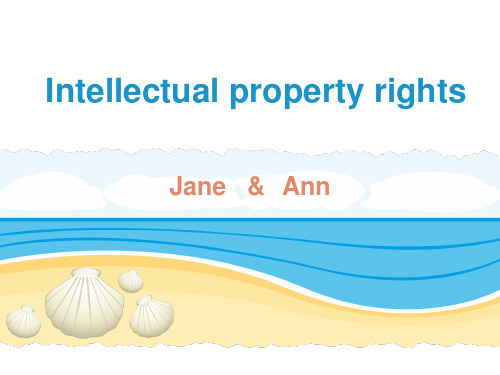
Jane & Ann
Contents
1 2 3 4 Definition Main contents Nature & Characteristic Copyright
Definition
Intellectual property rights refer to the rights of people to enjoy the achievements of their intellectual activities in accordance with the law. It's generally valid only in a limited period of time.
1
In accordance with the law, it is not necessary to perform any procedures or to publish the necessary conditions. Copyright includes both personal right and property right, and the content of power is rich.
Copyright is a form of protection provided to the authors of “original works of authorship ” including literary ,dramatic , musical ,artistic ,and certain other intellectual works , both published and unpublished.
知识产权保护 intellectual property rights protection
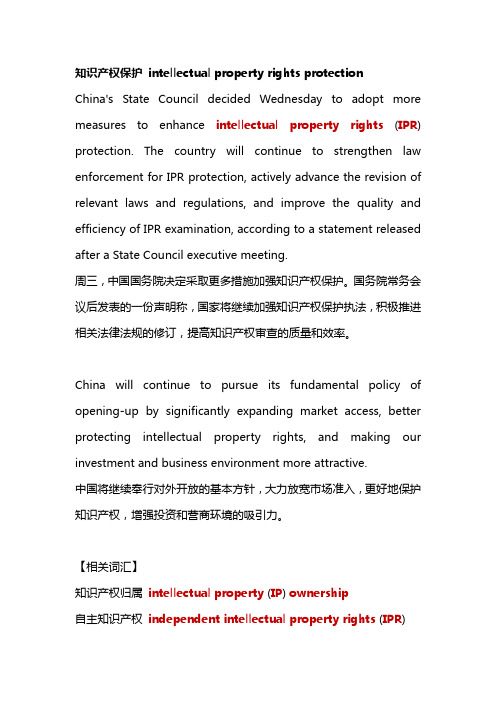
知识产权保护intellectual property rights protectionChina's State Council decided Wednesday to adopt more measures to enhance intellectual property rights(IPR) protection. The country will continue to strengthen law enforcement for IPR protection, actively advance the revision of relevant laws and regulations, and improve the quality and efficiency of IPR examination, according to a statement released after a State Council executive meeting.周三,中国国务院决定采取更多措施加强知识产权保护。
国务院常务会议后发表的一份声明称,国家将继续加强知识产权保护执法,积极推进相关法律法规的修订,提高知识产权审查的质量和效率。
China will continue to pursue its fundamental policy of opening-up by significantly expanding market access, better protecting intellectual property rights, and making our investment and business environment more attractive.中国将继续奉行对外开放的基本方针,大力放宽市场准入,更好地保护知识产权,增强投资和营商环境的吸引力。
【相关词汇】知识产权归属intellectual property (IP) ownership自主知识产权independent intellectual property rights (IPR)知识产权强国intellectual property rights (IPR) powerhouse。
Intellectual Property Law1
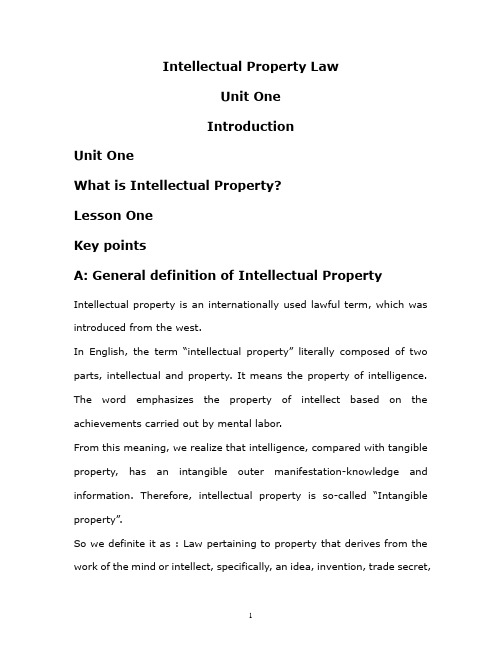
Intellectual Property LawUnit OneIntroductionUnit OneWhat is Intellectual Property?Lesson OneKey pointsA: General definition of Intellectual Property Intellectual property is an internationally used lawful term, which was introduced from the west.In English, the term “intellectual property” literally composed of two parts, intellectual and property. It means the property of intelligence. The word emphasizes the property of intellect based on the achievements carried out by mental labor.From this meaning, we realize that intelligence, compared with tangible property, has an intangible outer manifestation-knowledge and information. Therefore, intellectual property is so-called “Intangible property”.So we definite it as : Law pertaining to property that derives from the work of the mind or intellect, specifically, an idea, invention, trade secret,process, program, data, formula, patent, copyright, or trademark or application, right, or registration.Intellectual property implies that people enjoy their rights based on their achievements out of their intelligence according to the law. It has a broad sense and a narrow sense.A:知识产权的一般定义知识产权是一种国际通用的合法的术语,从西方引入。
电子商务平台知识产权保护责任书
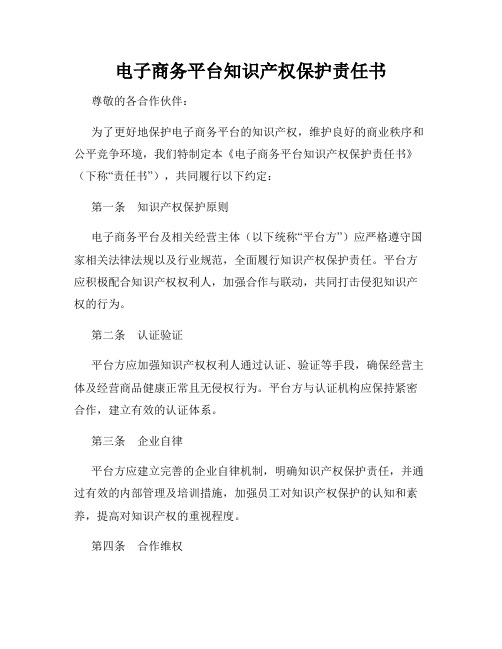
电子商务平台知识产权保护责任书尊敬的各合作伙伴:为了更好地保护电子商务平台的知识产权,维护良好的商业秩序和公平竞争环境,我们特制定本《电子商务平台知识产权保护责任书》(下称“责任书”),共同履行以下约定:第一条知识产权保护原则电子商务平台及相关经营主体(以下统称“平台方”)应严格遵守国家相关法律法规以及行业规范,全面履行知识产权保护责任。
平台方应积极配合知识产权权利人,加强合作与联动,共同打击侵犯知识产权的行为。
第二条认证验证平台方应加强知识产权权利人通过认证、验证等手段,确保经营主体及经营商品健康正常且无侵权行为。
平台方与认证机构应保持紧密合作,建立有效的认证体系。
第三条企业自律平台方应建立完善的企业自律机制,明确知识产权保护责任,并通过有效的内部管理及培训措施,加强员工对知识产权保护的认知和素养,提高对知识产权的重视程度。
第四条合作维权知识产权权利人与平台方应加强沟通,建立健全的信息互通机制,及时互通知识产权侵权线索。
平台方应积极配合知识产权权利人进行侵权调查,对查实的侵权行为给予打击,并及时删除、屏蔽相关侵权内容。
第五条违规处罚平台方应建立有效的监测、监控机制,及时发现侵犯知识产权的行为,对违规行为严格进行处理。
违规行为包括但不限于盗用他人商标、仿冒他人商标、销售侵权商品等行为,平台方可采取下架、冻结账号、清退货款等措施进行处理。
第六条信息公示平台方应在电子商务平台上公示知识产权保护相关政策、措施、处理结果等信息,提高用户和商家对知识产权保护的认知,并鼓励用户积极监督举报侵权行为。
第七条知识产权权利人支持平台方与知识产权权利人应建立良好的合作关系,共同推动知识产权保护工作的有效开展。
知识产权权利人应提供必要的技术支持和信息,配合平台方加强监测、打击侵权行为。
第八条监督与评估相关政府机关及第三方组织可对平台方的知识产权保护工作进行监督与评估,对履行责任不力、违反相关规定的平台方将承担相应的法律责任和商业惩罚。
中华人民共和国知识产权海关保护条例(英文版)
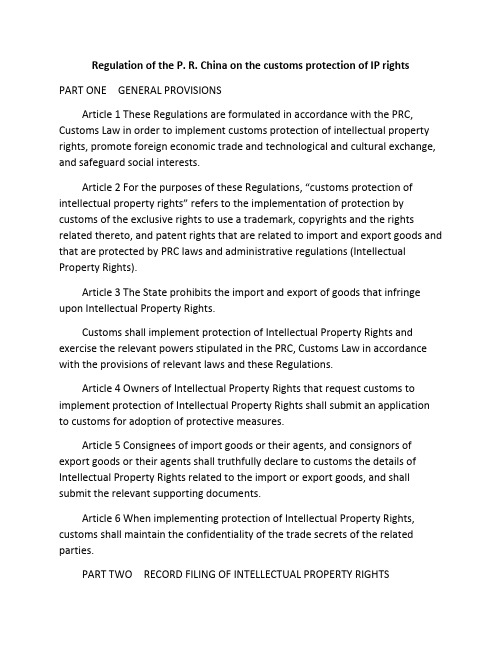
Regulation of the P. R. China on the customs protection of IP rightsPART ONE GENERAL PROVISIONSArticle 1 These Regulations are formulated in accordance with the PRC, Customs Law in order to implement customs protection of intellectual property rights, promote foreign economic trade and technological and cultural exchange, and safeguard social interests.Article 2 For the purposes of these Regulations, “customs protection of intellectual property rights” refers to the implementation of protection by customs of the exclusive rights to use a trademark, copyrights and the rights related thereto, and patent rights that are related to import and export goods and that are protected by PRC laws and administrative regulations (Intellectual Property Rights).Article 3 The State prohibits the import and export of goods that infringe upon Intellectual Property Rights.Customs shall implement protection of Intellectual Property Rights and exercise the relevant powers stipulated in the PRC, Customs Law in accordance with the provisions of relevant laws and these Regulations.Article 4 Owners of Intellectual Property Rights that request customs to implement protection of Intellectual Property Rights shall submit an application to customs for adoption of protective measures.Article 5 Consignees of import goods or their agents, and consignors of export goods or their agents shall truthfully declare to customs the details of Intellectual Property Rights related to the import or export goods, and shall submit the relevant supporting documents.Article 6 When implementing protection of Intellectual Property Rights, customs shall maintain the confidentiality of the trade secrets of the related parties.PART TWO RECORD FILING OF INTELLECTUAL PROPERTY RIGHTSArticle 7 An owner of Intellectual Property Rights may apply to the General Administration of Customs for record filing of his Intellectual Property Rights according to the provisions hereof. To apply for record filing, an application form shall be submitted. An application form shall include the following particulars:1. the name or personal name, place of registration or nationality, etc. of the owner of the Intellectual Property Rights;2. the name, details and the relevant information of the Intellectual Property Rights;3. the details of the exercise of the Intellectual Property Rights license;4. the name, place of origin, customs at the point of entry/exit, importers and exporters, major characteristics, and prices, etc. of the goods of which the Intellectual Property Rights are lawfully exercised by the owner of Intellectual Property Rights; and5. the manufacturers, importers and exporters, customs at the point of entry/exit, major characteristics, and prices, etc. of goods that are known to have infringed upon Intellectual Property Rights.Where there are supporting documents for the contents of the application form specified in the preceding paragraph, the owner of Intellectual Property Rights shall attach the supporting documents.Article 8 The General Administration of Customs shall, within 30 working days of the date of receipt of all application documents, render a decision on whether to grant approval for record filing, and shall notify the applicant in writing. Where approval for record filing is not granted, the reasons therefore shall be stated.The General Administration of Customs shall not grant approval for record filing in any of the following circumstances:1. the application documents are incomplete or invalid;2. the applicant is not the owner of the Intellectual Property Rights; or3. the Intellectual Property Rights are no longer protected by laws or administrative regulations.Article 9 If customs discovers that an owner of Intellectual Property Rights that applies for record filing of Intellectual Property Rights has not provided the relevant details or documents truthfully, the General Administration of Customs may revoke its filed record.Article 10 A filed record for customs protection of Intellectual Property Rights shall be effective as of the date on which the General Administration of Customs grants approval for record filing, and shall be valid for 10 years.Where the Intellectual Property Rights are valid, the owner of the Intellectual Property Rights may, within six months prior to the expiration of the term of validity of the filed record for customs protection of Intellectual Property Rights, apply to the General Administration of Customs for an extension of the filed record. The term of validity of each extension of a filed record shall be 10 years.Where no application for extension has been made upon the expiration of the term of validity of a filed record for customs protection of Intellectual Property Rights, or the Intellectual Property Rights are no longer protected by laws or administrative regulations, the filed record for customs protection of Intellectual Property Rights shall immediately become void.Article 11 Where there is a change in the details of a filed record of Intellectual Property Rights, the owner of the Intellectual Property Rights shall, within 30 working days of the date on which the change occurs, carry out the amendment or cancellation procedures with the General Administration of Customs.Where the owner of the Intellectual Property Rights does not apply to the amendment or cancellation procedures in accordance with the preceding paragraph so as to seriously affect other’s lawful import or export and the Customs supervision according to law, the General Administration of Customs can remove the record upon the application of the stakeholders or take the initiative to do so.PART THREE APPLICATION FOR IMPOUNDMENT OF GOODS SUSPECTED OF INFRINGING UPON RIGHTS, AND THE HANDLING THEREOFArticle 12 Where an owner of Intellectual Property Rights discovers that goods suspected of infringing upon rights are about to be imported or exported, he may submit an application for impoundment of goods suspected of infringing upon rights to the customs of the place where the goods are to enter into, or exit from, China.Article 13 Where an owner of Intellectual Property Rights requests customs to impound goods suspected of infringing upon rights, he shall submit an application form and the relevant supporting documents, and shall provide evidence that is sufficient to prove that the infringement clearly exists.An application form shall include the following main particulars:1. the name or personal name, place of registration or nationality, etc. of the owner of the Intellectual Property Rights;2. the name, details and the relevant information of the Intellectual Property Rights;3. the names of the consignees and consignors of the goods suspected of infringing upon rights;4. the name and specifications, etc. of the goods suspected of infringing upon rights; and5. the port by which, the time at which and the means of transportation by which, the goods suspected of infringing upon rights may enter into, or exit from, China.Where the goods suspected of infringing upon rights are suspected of infringing upon Intellectual Property Rights that are filed for record, the application form shall also include the customs record number.Article 14 Where an owner of Intellectual Property Rights requests customs to impound goods suspected of infringing upon rights, he shall provide to customsa guarantee equal to the value of the goods for compensation of any loss that may be incurred by the consignee or the consignor due to improper application, and for payment of fees for the storage, custody and disposal, etc. of the goods after they are impounded by customs. Where an owner of Intellectual Property Rights pays the fees for storage and custody directly to the storage provider, such fees shall be deducted from the guarantee. The specific procedures shall be formulated by the General Administration of Customs.Article 15 Where an owner of Intellectual Property Rights that applies for impoundment of goods suspected of infringing upon rights satisfies the provisions of Article 13 hereof and provides a guarantee in accordance with Article 14 hereof, customs shall impound the goods suspected of infringing upon rights, notify the owner of Intellectual Property Rights in writing, and deliver a certificate of impoundment by customs to the consignee or consignor.Where an owner of Intellectual Property Rights that applies for impoundment of goods suspected of infringing upon rights does not satisfy the provisions of Article 13 hereof or has not provided a guarantee in accordance with Article 14 hereof, customs shall reject the application and notify the owner of Intellectual Property Rights in writing.Article 16 Where customs discovers import or export goods that are suspected of infringing upon Intellectual Property Rights that are filed for record, it shall notify the owner of the Intellectual Property Rights immediately in writing. Where, within three working days of the date of delivery of the notification, the owner of the Intellectual Property Rights submits an application according to Article 13 hereof and provides a guarantee according to Article 14 hereof, customs shall impound the goods suspected of infringing upon rights, notify the owner of the Intellectual Property Rights in writing, and deliver a certificate of impoundment by customs to the consignee or consignor. Where the owner of the Intellectual Property Rights fails to submit an application or provide a guarantee within the time limit, customs may not impound the goods.Article 17 An owner of Intellectual Property Rights and the consignee or consignor may inspect the relevant goods upon the approval of customs.Article 18 Where the consignee or consignor considers that his goods have not infringed upon the Intellectual Property Rights of the owner of Intellectual Property Rights, he shall submit a written explanation to customs and attach the relevant evidence.Article 19 Where a consignee or consignor of goods suspected of infringing upon patent rights considers that his import or export goods have not infringed upon patent rights, he may, after providing a guarantee equal to the value of the goods, request customs to release his goods. If the owner of Intellectual Property Rights fails to institute an action at a people’s court within a reasonable time period, customs shall return the guarantee.Article 20 If, after customs has discovered import or export goods suspected of infringing upon Intellectual Property Rights that are filed for record and has notified the owner of the Intellectual Property Rights, the owner of the Intellectual Property Rights requests customs to impound the goods suspected of infringing upon rights, customs shall, within 30 working days of the date of impoundment, investigate and confirm whether the impounded goods suspected of infringing upon rights have infringed upon Intellectual Property Rights. If it cannot confirm an infringement, it shall notify the owner of the Intellectual Property Rights immediately in writing.Article 21 Where customs conducts an investigation into the impounded goods suspected of infringing upon rights and requests the assistance of the department in charge of Intellectual Property Rights, the relevant department in charge of Intellectual Property Rights shall provide assistance.Where the department in charge of Intellectual Property Rights requests customs to provide assistance in the handling of rights infringement cases involving import and export goods, customs shall provide assistance.Article 22 Where customs conducts an investigation into the impounded goods suspected of infringing upon rights and the relevant details, the owner of Intellectual Property Rights and the consignee or consignor shall coordinate with the investigation.Article 23 An owner of Intellectual Property Rights may, after applying to customs for adoption of protective measures, apply to the people’s court for an order of cessation of the infringing act or preservation of property for the impounded goods suspected of infringing upon rights prior to the institution of action in accordance with the provisions of the PRC, Trademark Law, the PRC, Copyright Law or the PRC, Patent Law.Customs that receives the notice to assist in execution of an order of cessation of an infringing act or preservation of property from the p eople’s court shall provide assistance.Article 24 Customs shall release the impounded goods suspected of infringing upon rights in any of the following circumstances:1. customs impounds goods suspected of infringing upon rights according to Article 15 hereof, and has not received the notice to assist in execution from the people’s court within 20 working days from the date of impoundment;2. customs impounds goods suspected of infringing upon rights according to Article 16 hereof, and has not received the notice to assist in execution from the people’s court within 50 working days from the date of impoundment, and cannot confirm that the impounded goods suspected of infringing upon rights has infringed upon Intellectual Property Rights after investigation;3. the consignee or consignor of the goods suspected of infringing upon patent rights requests customs to release his goods after providing a guarantee equal to the value of the goods; or4. customs considers that the consignee or consignor has sufficient evidence to prove that his goods have not infringed upon the Intellectual Property Rights of the owner of Intellectual Property rights.Article 25 Where customs impounds goods suspected of infringing upon rights according to the provisions hereof, the owner of the Intellectual Property Rights shall pay the relevant fees for storage, custody and disposal, etc. Where the owner of the Intellectual Property Rights has not paid the relevant fees,customs may deduct such fees from the guarantee he provides to customs, or request the guarantor to perform the relevant guarantee liability.Where goods suspected of infringing upon rights are confirmed as having infringed upon Intellectual Property Rights, the owner of the Intellectual Property Rights may include the relevant fees for storage, custody and disposal, etc. he has paid in the reasonable expenditure paid for cessation of the infringing acts.Article 26 Where customs discovers a case suspected of a criminal offence during implementation of protection of Intellectual Property Rights, it shall hand over the case to the public security authority according to law for handling.PART FOUR LEGAL LIABILITYArticle 27 Where impounded goods suspected of infringing upon rights are confirmed as having infringed upon Intellectual Property Rights after investigation by customs, customs shall confiscate the goods.After customs has confiscated the goods that have infringed upon Intellectual Property Rights, it shall notify the owner of the Intellectual Property Rights in writing of the relevant details of such goods.Where confiscated goods that have infringed upon Intellectual Property Rights can be used for public welfare, customs shall transfer the goods to the relevant public welfare organizations to be used for public welfare. Where the owner of the Intellectual Property Rights wishes to acquire the goods, customs may transfer the goods to the owner of the Intellectual Property Rights for compensation. Where confiscated goods that has infringed upon Intellectual Property Rights cannot be used for public welfare and the owner of the Intellectual Property Rights does not wish to acquire the goods, customs may auction off the goods according to law after removing the infringing characteristics. Where the infringing characteristics cannot be removed, customs shall destroy the goods.Article 28 Where articles carried or sent by mail by individuals into or out of China exceed the amount for personal use or the reasonable amount and infringeupon the Intellectual Property Rights stipulated in Article 2 hereof, customs shall confiscate such articles.Article 29 Where, after customs has accepted an application for record filing of protection of Intellectual Property Rights and for adoption of protective measures for Intellectual Property Rights, an owner of Intellectual Property Rights cannot provide precise details and as a result, the goods infringing upon rights are not discovered, or the protective measures are not adopted in a timely manner or effectively, the owner of the Intellectual Property Rights shall bear the liability himself.Where, after an owner of Intellectual Property Rights has requested customs to impound goods suspected of infringing upon rights, customs cannot confirm whether the impounded goods suspected of infringing upon rights has infringed upon the Intellectual Property Rights of the owner of Intellectual Property Rights, or the people’s court rules that the goods have not infringed upon the Intellectual Property Rights of the owner of Intellectual Property Rights, the owner of Intellectual Property Rights shall be liable for compensation according to law.Article 30 Where the import or export of goods that infringe upon Intellectual Property Rights constitutes a criminal offence, criminal liability shall be pursued according to law.Article 31 Where the personnel of customs are derelict in their duties, abuse their authority or practice graft in their implementation of protection of Intellectual Property Rights, and a criminal offence is constituted, their criminal liability shall be pursued according to law. Where the same is insufficient to constitute a criminal offence, they shall be subjected to administrative penalty according to law.PART FIVE SUPPLEMENTARY PROVISIONSArticle 32 Where an owner of Intellectual Property Rights handles record filing of his Intellectual Property Rights with the General Administration of Customs, he shall pay the fee for record filing in accordance with the relevant State provisions.Article 33 These Regulations shall be implemented as of 1 March 2004. The PRC, Customs Protection of Intellectual Property Rights Regulations promulgated by the State Council on 5 July 1995 shall be simultaneously repealed.。
知识产权的英语词汇
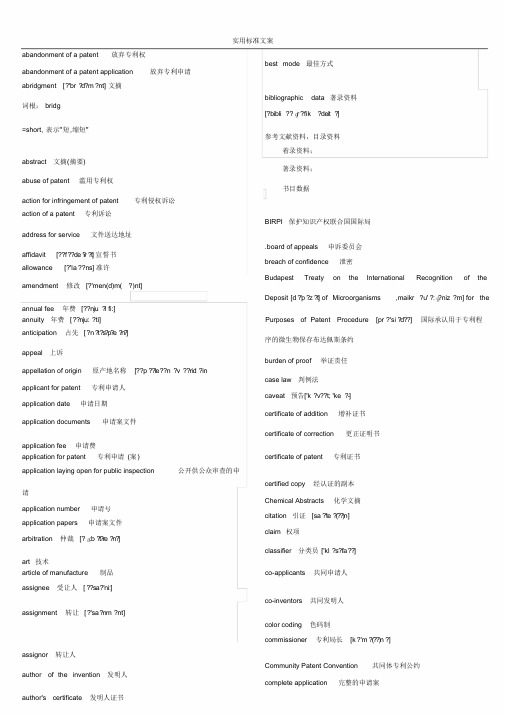
实用标准文案abandonment of a patent 放弃专利权best mode 最佳方式abandonment of a patent application 放弃专利申请abridgment [ ?'br ?d?m ?nt] 文摘bibliographic data 著录资料词根:bridg[?bibli ??ɡr ?fik ?deit ?]=short, 表示"短,缩短"参考文献资料,目录资料着录资料;abstract 文摘(摘要)著录资料;abuse of patent 滥用专利权书目数据action for infringement of patent 专利侵权诉讼action of a patent 专利诉讼BIRPI 保护知识产权联合国国际局address for service 文件送达地址.board of appeals 申诉委员会affidavit [??f ??de ?v?t]宣誓书breach of confidence 泄密allowance [?'la ??ns] 准许Budapest Treaty on the International Recognition of the amendment 修改[?'men(d)m( ?)nt]Deposit [d ?'p ?z ?t]of Microorganisms ,maikr ?u' ?:ɡ?niz ?m] for the annual fee 年费[ ??nju ?l fi:]annuity 年费[ ??nju: ?ti] Purposes of Patent Procedure [pr ?'si ?d??] 国际承认用于专利程anticipation 占先[ ?n ?t?s?p?e?n?]序的微生物保存布达佩斯条约appeal 上诉burden of proof 举证责任appellation of origin 原产地名称[??p ??le ??n ?v ??rid ?incase law 判例法applicant for patent 专利申请人caveat 预告['k ?v??t; 'ke ?-]application date 申请日期certificate of addition 增补证书application documents 申请案文件certificate of correction 更正证明书application fee 申请费application for patent 专利申请(案) certificate of patent 专利证书application laying open for public inspection 公开供公众审查的申certified copy 经认证的副本请Chemical Abstracts 化学文摘application number 申请号citation 引证[sa ?'t e ?(??)n]application papers 申请案文件claim 权项arbitration 仲裁[?ɑ:b ?t?r e ?n?]classifier 分类员['kl ?s?fa ??]art 技术article of manufacture 制品co-applicants 共同申请人assignee 受让人[ ??sa ?'ni:]co-inventors 共同发明人assignment 转让[ ?'sa ?nm ?nt]color coding 色码制commissioner 专利局长[k ?'m ?(??)n ?]assignor 转让人Community Patent Convention 共同体专利公约author of the invention 发明人complete application 完整的申请案author's certificate 发明人证书complete description 完整的叙述complete specification 完整的说明书basic patent 基本专利comptroller 专利局长[k ?m'tr ??l ?; k ?mp-] Berne Convention 伯尔尼公约compulsory license 强制许可证['la ?sns] 英[b ?:n,b ??n] 美[b ?n, b ?rn]conception 概念conception date 概念日期confidential application 机密申请Berne Union 伯尔尼联盟confidential information 保密情报精彩文档实用标准文案effective filing date 实际申请日期conflict award 冲突裁定employee ’s invention雇员发明conflict procedure 冲突程序[pr ?'si ?d ??EPO 欧洲专利局conflicting applications 冲突申请案European Patent Office 欧洲专利局continuation application 继续申请ESARIPO 英语非洲工业产权组织esripou continuation-in-part application 部分继续申请案European Patent Convention 欧洲专利公约contractual license 契约性许可证evidence 证据contributory infringement 简介侵犯[k ?n'tr ?b j?t( ?)r ?]examination 审查convention application 公约申请examination countries 审查制国家convention country 公约国examination for novelty 新颖性审查convention date 公约日期examiner 审查员Convention Establishing the World Intellectual Propertyexaminer ’s repor审t 查员报告Organization 建立世界知识产权组织公约exclusive license 独占性许可证convention period 公约期限exclusive right 专有权convention priority 公约优先权[pra ?'?r?t ?]experimental use 实验性使用copyright 版权expired patent 期满专利[iks'pai ?d]correction slip 勘误表exploitation of a patent 实施专利[ekspl ??'te ?(??)n] counter pleadings 反诉状exposition priority 展览优先权counterclaim 反诉expropriation 征用[eks,pr ??pr ?'e??n]country code 国家代号extension of term of a patent 延长专利期限cross license 交叉许可证fee 费用[?k'sten ?(?)n; ek-]data 资料FICPI 国际工业产权律师联合会data exchange agreement 资料交换协议file copy 存档原件data of application 申请日期filing date 申请日期date of grant 授予日期filing fee 申请费date of issue 颁发日期[' ?u?:]filing of an application 提出申请date of patent 专利日期final action 终局决定书date of publication 公布日期first-to-file principle 先申请原则dedication to the public 捐献于公众first-to-invention principle 先发明原则defendant 被告人force majeure 不可抗力[m ?'??:defenses 辩护foreign patent application 外国专利申请defensive publication 防卫性公告formal examination 形式审查deferred examination 延迟审查gazette 公报[ɡ?'zet]dependent claim 从属权项Geneva Treaty on the International Recording of Scientific dependent patent 从属专利Discoveries 关于科学发现国际注册日内瓦条约[d ??'ni:v ?] Derwent Publications Ltd. 德温特出版有限公司grace period 宽限期design patent 外观设计专利grant of a patent 授予专利权development 发展holder of a patent 专利持有人disclaimer 放弃权项ICIREPAT 专利局间情报检索国际合作巴黎联盟委员会disclosure 公开Paris Union Committee for International Cooperation in division 分案Information Retrieval among Patent Offices 专利局间情报检索国divisional application 分案申请际合作巴黎联盟委员会[r ?t?ri:vl]domination patent 支配专利IFIA 国际发明人协会联合会drawing 附图duration of patent 专利有效期[dju ?re ?n?]International Federation of Inventor cia’t ions A国ss际o 发明人协会联合会economic patent 经济专利精彩文档IBB 国际专利研究所joint invention 共同发明Institut International des Brevets 国际专利研究所joint inventors 共同发明人imitation 仿造joint patentees 共同专利权人impeachment 控告journal 公报improvement 改进judgment 判决improvement patent 改进专利junior party 后申请方independence of patents 专利独立know-how 技术诀窍indication of source 产地标记lapsed patent 已终止的专利indirect infringement 间接侵犯lawsuit of a patent 专利诉讼industrial applicability 工业实用性legal person 法人industrial design 工业品外观设计legend 说明industrial property 工业产权LES International 国际许可贸易执行人协会information in the public domain 公开情报Licensing Executives Society International 国际许可贸易执行人协infringement of a patent 侵犯专利权会infringement of a trade mark 侵犯商标权letters patent 专利证书INID 著录资料识别码license 许可证ICIREPAT Numbers for the Identification of Data 著录资料识别码license agreement 许可证协议INPADOC 国际专利文献中心license of course 当然许可证INSPEC 国际物理学和工程情报服务部licensing 许可证贸易insufficient disclosure 公开不允分licensor 许可人intellectual property 知识产权Lisbon Agreement for the Protection of Appellations of Origin and interdependent patents 相互依存的专利their International Registration 保护原产地名称及国际注册里斯本interference procedure 抵触程序协定interlocutory injunction 中间禁止令Locarno Agreement Establishing an International Classification for interlocutory order 中间命令Industrial Design 建立工业品外观设计国际分类洛迦诺协定International Convention for the Protection of New Varieties of loss of a patent 专利权的丧失Plants 保护植物新品种国际公约Madrid Agreement Concerning the International Registration of International Patent Classification Agreement 国际专利分类协定Marks 商标国际注册马德里协定International Preliminary Examining Authority 国际初审单位Madrid Agreement for the Repression of False or Deceptive international protection 国际保护Indications of Source on Goods 制止商品产地虚假或欺骗性标记International Searching Authority 国际检索单位马德里协定invalidation 无效main patent 主专利invention 发明maintenance fee 维持费inventive step 独创性marking 标记inventor 发明人memorandum of understanding 谅解备忘录inventor ’srt ic fie cate发明人证书method 方法IPC 国际专利分类microforms 微缩文件International Patent Classification 国际专利分类minimum documentation 最少限度检索文献issue of a patent 办法专利minimum royalties 最低提成费joint applicants 共同申请人misuse of patent 滥用专利权精彩文档mixed license 混合许可证patent of addition 增补专利model laws 示范法patent of confirmation 确认专利most-favoured provision 最惠条款patent of importation 输入专利name of invention 发明名称patent of introduction 引进专利national treatment 国民待遇patent of revalidation 再效专利natural person 自然人patent office 专利局neighboring rights 邻接权patent pending 专利未决new varieties of plants 植物新品种patent right 专利权Nice Agreement Concerning the International Classification of patent rules 专利实施细则Goods and Services for the Purposes of the Registration of Marks patent system 专利制度商标注册用商品与服务国际分类尼斯协定patentability 专利性non-examining countries 不审查制国家patented invention 专利发明non-exclusive license 非独占性许可patentee 专利权人non-obviousness 非显而易见性patenting 授予专利权non-use of a patent 不实施专利PCT 专利合作条约notary public 公正机关PCT Union 专利合作条约notice of infringement 侵权通知pending application 未决申请novelty 新颖性period of a patent 专利有效期OAPI 非洲知识产权组织person skilled in the art 所属技术领域的专业人员objection 异议petition 请求书office action 专利局审查决定书petty patent 小专利opposition 异议plaintiff 原告人originality 独创性plant patent 植物专利owner of a patent 专利所有人pleadings 起诉状parent application 原申请precautional patent 预告专利Paris Convention 巴黎公约precedents 判例Paris Union 巴黎联盟prescription 时效patent 专利prevention of unfair competitionprincipal patent 主专利patent act 专利法prior art 先有技术patent agent 专利代理人prior use 先用patent applied for 已申请专利priority 优先权patent attorney 专利律师priority claim 优先权声明patent classification 专利分类priority declaration 优先权声明patent documentation 专利文献process patent 方法专利patent documents 专利文件processing of an application 申请案的处理patent families 同族专利product patent 产品专利patent for an invention 发明专利provisional specification 临时说明书patent law 专利法publication 公布patent license 专利许可证reclassification 再分类patent number 专利号reexamination 复审精彩文档refusal 驳回technology transfer 技术转移register of patents 专利登记册temporary protection 临时保护registered patent 登记专利term of a patent 专利有效期世贸组织WTO WORLD TRADE registered trade mark 注册商标ORGANIZATION关税及贸易总协定《GATT 》GENERAL AGREEMENT ON registration 登记registration countries 登记制国家TARIFFS ANDreissue patent 再颁发专利TRADE亚太经济合作组织《A PEC 》ASIA PACIFIC ECONOMIC rejection 驳回remedy 补救COOPERATION与贸易有关的知识产权协议《TRIPS 》AGREEMENT ON renewal fee 续展费request 请求书TRADE RELATED ASPECTS OF INTELLECTUAL restoration of a lapsed patent 恢复已终止的专利PROPERTY RIGHTS世界知识产权组织《WIPO 》WORLD INTELLECTUAL restricted conditions 限制条款review 复审PROPERTYrevival of an abandoned application 恢复已放弃的申请ORGANIZATION保护知识产权联合国际局INTERNATIONAL BOARD OF revocation of a patent 撤销专利royalties 提成费INTELLECTUALScience Abstracts 科学文摘PROPERTY RIGHT保护工业产权巴黎公约PARIS CONVENTION FOR THE scientific discovery 科学发现scope of protection 保护范围PROTECTION OF INDUSTRIAL PROPERTY商标国际注册马德里协定MADRID AGREEMENT seal 盖章search 检索CONCERNING THEsecret patent 机密专利INTERNATIONAL REGISTRATION OF MARKS商标注册条约《TRT 》TRADE MARK REGISTRATION service invention 职务发明service mark 服务标记TREATY商标注册用商品与国际分类尼斯协定NICE AGREEMENT signature 签署simple license 普通许可证CONCERNING THE INTERNATIONAL CLASSIFICATION single applicant 单独申请人OF GOODS AND SERVICES FOR THEsliding scale of royalties 滑动提成费PURPOSE OF THE REGISTRATION OF MARKSsole license 排他性许可证建立商标图形要素国际分类维也纳协定specification 说明书VIENNA AGREEMENT FOR ESTABLISHING AND state of the art 先有技术水平INTERNATIONAL CLASSIFICATION OF THE statement of claim 诉讼陈述FIGURATIVE ELEMENTS OF MARKS专利合作条约《PCT 》PATENT CO-OPERATION TREATY statement of defense 辩护陈述共同体专利公约COMMUNITY PATENT CONVENTION substance patent 物质专利斯特拉斯堡协定《SA 》STRASBOURG AGREEMENT substantive examination 实质性审查工业外观设计国际保存海牙协定THE HAGUE AGREEMENT succession 继承sufficiency of description 充分描述CONCERNING THE INTERNATIONAL DEPOSIT OF technical assistance 技术协助INDUSTRIAL DESIGNS工业外观设计国际分类洛迦诺协定LOCARNO AGREEMENT technical data 技术资料精彩文档注册申请号APPLICATION NUMBER ON ESTABLISHING AND INTERNATIONAL商标注册证TRADE MARK REGISTRATION CERTIFICATE CLASSIFICATION FOR INDUSTRIAL DESIGNS商标,外观设计与地理标记法律常设委员会(SCT )STANDING 商标注册号TRADE MARK REGISTRATION NUMBER商标注册日TRADE MARK REGISTRATION DATE COMMITTEE ON THE LAW OF TRADEMARK ,商标注册簿TRADE MARK REGISTERED BOOK INDUSTRIAL DESIGN AND GEOGRAPHICAL注册有效期THE TERM OF VALIDITY INDICATION国际专利文献中心《INPADOC 》INTERNATIONAL PATENT 商标注册官EXAMINATION FOR TRADE MARK DOCUMENTATION CENTER REGISTRATION欧洲专利局《EPO 》EUROPEAN PATENT OFFICE 注册查询TRADE MARK ENQUIRIES欧洲专利公约EUROPEAN PATENT CONVENTION 注册续展RENEWAL OF TRADE MARK比荷卢商标局TRADE MARK OFFICE OF BELGIUM -分别申请SEPARATE APPLICATION重新申请NEW REGISTRATIONHOLLAND -LUXEMBURG法语非洲知识产权组织ORGANIZATION OF AFRICAN 别行申请NEW APPLICATION变更申请APPLICATION REGARDING CHANGES INTELLECTUAL PROPERTY国际商标协会THE INTERNATIONAL TRADEMARK 注册代理TRADE MARK AGENCY注册公告TRADE MARK PUBLICATION ASSOCIATION中华人民共和国商标法TRADEMARK LAW OF THE 申请注册APPLICATION FOR REGISTRATION续展注册RENEWAL OF REGISTRATION PEOPLES REPUBLIC OF CHINA英国商标法转让注册REGISTRATION OF ASSIGNMENT变更注册人名义/地址/其它注册事项MODIFICATION OF TRADEMARK LAW OF UNITED KINGDOM OF GREAT BRITAIN AND NORTHERN IRELAND NAME /ADDRESS OF REGISTRANT /OTHER MATTERS美国商标法TRADEMARK LAW OF THE UNITED 补发商标证书REISSUANCE OF REGISTRATION STATES OF AMERICA CERTIFICATE日本商标法JAPANESE TRADEMARK LAW 注销注册商标REMOVAL商标TRADE MARK 证明CERTIFICATION商标局TRADE MARK OFFICCE 异议OPPOSITION商标法TRADE MARK LAW 使用许可合同备案RECORDAL OF LICENSE CONTRACT文字商标WORD MARK 驳回商标复审REVIEW OF REFUSED TRADEMARK图形商标FIGURATIVE MARK 驳回续展复审REVIEW OF REFUSED RENEWAL组合商标ASSOCIATED MARK 驳回转让复审REVIEW OF REFUSED ASSIGNMENT保证商标CERTIFICATION MARK 撤销商标复审REVIEW OF ADJUDICATION ON 集体商标COLLECTIVE MARKOPPOSITION驰名商标WELL -KNOWN MARK 异议复审REVIEW OF ADJUDICATION ON OPPOSITION 著名商标FAMOUS MARK 争议裁定ADJUDICATION ON DISPUTED REGISTERED 近似商标SIMILAR MARKTRADEMARK防御商标DEFENSIVE MARK 撤销注册不当裁定ADJUDICATION ON CANCELLATION OF 服务标记SERVICE MARKIMPROPERLY REGISTERED TRADEMARK注册商标REGISTERED MARK 撤销注册不当复审REVIEW ON CANCELLATION OF 商标注册申请人TRADE MARK REGISTRANTIMPROPERLY REGISTERED TRADEMARK注册申请日APPLICATION DATE OF TRADE MARK 处理商标纠纷案件DEALING WITH INFRINGEMENT精彩文档优先权PRIORITY 货源标记INDICATION OF SOURCE注册申请优先日DATE OF PRIORITY 原产地名称APPELLATION OF ORIGIN (AOS )注册商标使用人USER OF REGISTERED TRADE MARK 地理标记GEOGRAPHICAL INDICATION (GI )注册商标专用权EXCLUSIVE RIGHT TO USE1.A patent is a governmental grant of an exclusive monopoly REGISTERED TRADE MARKas an incentive and a reward for a new invention. 注册商标的转让ASSIGNMENT OF REGISTERED TRADEMARK专利权是政府对一项新发明授予的独立性权利,以给予发明鼓励和商标的许可使用LICENSING OF REGISTERED TRADE奖励。
保护知识产权的必要性高中英语作文

保护知识产权的必要性高中英语作文(中英文版)The Necessity of Protecting Intellectual Property RightsIn today's society, the protection of intellectual property rights (IPR) has become a topic of increasing importance.With the rapid development of technology and the internet, the value of intellectual property has been greatly magnified.Therefore, it is crucial to understand the significance of safeguarding intellectual property rights.To begin with, protecting intellectual property rights is essential for promoting innovation and creativity.When creators and inventors know that their intellectual property will be protected, they are more likely to invest time and resources into developing new ideas, products, and technologies.This encourages a culture of innovation, which in turn drives economic growth and competitiveness.Moreover, the protection of intellectual property rights is crucial for rewarding the efforts and skills of creators and inventors.By granting them exclusive rights over their creations, society encourages them to continue their work and contribute to the common good.This system of rewards and incentives ensures that intellectual property is not undervalued and that those who generate valuable intellectual property are adequately compensated.Furthermore, protecting intellectual property rights is important formaintaining fair competition in the marketplace.When intellectual property is protected, businesses are encouraged to compete based on the originality and quality of their products and services, rather than copying or plagiarizing the ideas of others.This fosters a level playing field and encourages businesses to invest in research and development, leading to better outcomes for consumers.Lastly, the protection of intellectual property rights is essential for respecting the rights of creators and inventors.Every individual has the right to their own ideas and creations, and it is no different for creators and inventors.By protecting their intellectual property rights, society respects their autonomy and recognizes the value of their work.In conclusion, the protection of intellectual property rights is of utmost importance in today's society.It encourages innovation, rewards creativity, maintains fair competition, and respects the rights of creators and inventors.Therefore, it is crucial for governments, businesses, and individuals to take measures to protect intellectual property rights.。
2011年考研英语二真题

2011年全国硕士研究生入学统一考试英语二Individuals and businesses have legal protection for intellectual property they create and own. Intellectual property _1_from creative thinking and may include products, _2_, processes, and ideas. Intellectual property is protected _3_ misappropriation (盗用) Misappropriation is taking the intellectual property of others without _4_ compensation and using it for monetary gain. Legal protection is provided for the _5_ of intellectual property. The three common types of legal protection are patents, copyrights, and trademarks.Patents provide exclusive use of inventions. If the U.S. Patent Office _6_ a patent, it is confirming that the intellectual property is _7_. The patent prevents others from making, using, or selling the invention without the owner’s _8_ for a period of 20 years.Copyright are similar to patents _9_ that they are applied to artistic works. A copyright protects the creator of an _10_ artistic or intellectual work, such as a song or a novel. A copyright gives the owner exclusive rights to copy, _11_, display, or perform the work. The copyright prevents others from using and selling the work. The _12_ of a copyright is typically the lifetime of the author _13_ an additional 70 years.Trademarks are words, names, or symbols that identify the manufacturer of a product and _14_ it from similar goods of others. A servicemark is similar to a trademark _15_ is used to identify service. A trademark prevents others from using the _16_ or a similar word, name, or symbol to take advantage of the recognition and _17_ of the brand or to create confusion in the marketplace. _18_ registration, a trademark is usually granted for a period of ten years. It can be _19_ for additional ten-year periods indefinitely as _20_ as the mark’s use continues.1. A. retrieves B. deviates C. results D. departs2. A. services B. reserves C. assumptions D. motions3. A. for B. with C. by D. from4. A. sound B. partial C. due D. random5. A. users B. owners C. masters D. executives6. A. affords B. affiliates C. funds D. grants7. A. solemn B. sober C. unique D. universal8. A. perspective B. permission C. conformity D. consensus9. A. except B. besides C. beyond D. despite10. A. absolute B. alternative C. original D. orthodox11. A. presume B. stimulate C. nominate D. distribute12. A. range B. length C. scale D. extent13. A. plus B. versus C. via D. until14. A. distract B. differ C. distinguish D. disconnect15. A. or B. but C. so D. whereas16. A. identical B. analogical C. literal D. parallel17. A. ambiguity B. utility C. popularity D. proximity18. A. From B. Over C. Before D. Upon19. A. recurred B. renewed C. recalled D. recovered20. A. long B. soon C. far D. wellSection II Reading ComprehensionPart ADirections: Read the following four passages. Answer the questions below each passage bychoosing A, B, C or D. Mark your answers on Answer Sheet 1 (40 points)Text 1Within a large concrete room, cut out of a mountain on a freezing-told island just 1,000 kilometers from the North Pole, could lie the future of humanity.The room is a vault (地下库) designed to hold around 2 million seeds, representing all known varieties of the world’s crops. It is being built to safeguard the world’s food supply against nuclear war, climate change, terrorism, rising sea levels, earthquakes and the collapse of electricity supplies. “If the worst came to the worst, this would allow the world to reconstruct agriculture on this planet.”says Cary Fowler, director of the Global Crop Diversity Trust, an independent international organization promoting the project.The Norwegian (挪威的) government is planning to create the seed bank next year at the request of crop scientists. The $3 million vault will be built deep inside a sandstone mountain on the Norwegian Arctic island of Spitsbergen. The vault will have metre-thick walls of reinforced concrete and will be protected behind two airlocks and high-security doors.The vault’s seed collection will represent the products of some 10,000 years of plant breeding by the world’s famers. Though most are no longer widely planted, the varieties contain vital genetic properties still regularly used in plant breeding.To survive, the seeds need freezing temperatures. Operators plan to replace the air inside the vault each winter, when temperatures in Spitsbergen are around -18℃. But even if some disaster meant that the vault was abandoned, the permanently frozen soil would keep the seeds alive. And even accelerated global warming would take many decades to penetrate the mountain vault. “This will be the world’s most secure gene bank,”says Fowler. “But its seeds will only be used when all other samples have gone for some reason.”The project comes at a time when there is growing concern about the safety of existing seed banks around the world. Many have been criticized for poor security, ageing refrigeration (冷藏) systems and vulnerable electricity supplies.The scheme won UN approval at a meeting of the Food and Agriculture Organization in Rome in October 2005. A feasibility study said the facility “would essentially be built to last forever”.21. The Norwegian vault is important in that _________________.A. the seeds in it represent the rarest varieties of world’s crops.B. the seeds in it could revive agriculture if the worst thing should happenC. it is built deep in a mountain on a freezing-cold Arctic islandD. it is strong enough against all disasters caused by man and nature22. The seed bank project was proposed by __________.A. the Norwegian governmentB. Norwegian farmersC. Spitsbergen residentsD. agricultural scientists23. The seeds in the vault will be stored ____________________.A. as samples of world crop varietiesB. as products of world plant breedingC. for their valuable genetic propertiesD. for their resistance to plant diseases24. For the seed bank project to be successful, the most important factor is probably________.A. constructing tight airlocksB. maintaining high securityC. keeping freezing temperaturesD. storing large quantities of seeds25. Which of the following statements is true?A. The Norwegian vault models after existing seed banksB. The Spitsbergen seed bank is expected to last 10,000 yearsC. The existing seed banks have potential problemsD. The UN financed the Spitsbergen seed bankText 2Both the number and the percentage of people in the United States involved in nonagricultural pursuits expanded rapidly during the half century following the Civil War, with some of the most dramatic increases occurring in the domains of transportation, manufacturing, and trade and distribution. The development of the railroad and telegraph systems during the middle third of the nineteenth century led to significant improvements in the speed, volume, and regularity of shipments and communications, making possible a fundamental transformation in the production and distribution of goods.In agriculture, the transformation was marked by the emergence of the grain elevators, the cotton presses, the warehouses, and the commodity exchanges that seemed to so many of the nation’s farmers the visible sign of a vast conspiracy against them. In manufacturing, the transformation was marked by the emergence of a “new factory system”in which plants became larger, more complex, and more systematically organized and managed. And in distribution, the transformation was marked by the emergence of the jobber, the wholesaler, and the mass retailer. These changes radically altered the nature of work during the half century between 1870 and 1920.To be sure, there were still small workshops, where skilled craftspeople manufactured products ranging from newspapers to cabinets to plumbing fixtures. There were the sweatshops in city tenements, where groups of men and women in household settings manufactured clothing or cigars on a piecework basis. And there were factories in occupations such as metalwork where individual contractors presided over what were essentially handicraft proprietorships that coexisted within a single building. But as the number of wage earners in manufacturing rose from 2.7 million in 1880 to 4.5 million in 1900 to 8.4 million in 1920, the number of huge plants like the Baldwin Locomotive Works in Philadelphia burgeoned, as did the size of the average plant. (The Baldwin Works had 600 employees in 1855, 3,000 in 1875, and 8,000 in 1900.) By 1920, at least in the northeastern United States where most of the nation’s manufacturing wage earners were concentrated, three-quarters of those worked in factories with more than 100 employees and 30 percent worked in factories with more than 1,000 employees.26. What can be inferred from the passage about the agricultural sector of the economy after the Civil War?A. New technological developments had little effect on farmers.B. The percentage of the total population working in agriculture declined.C. Many farms destroyed in the war were rebuilt after the war.D. Farmers achieved new prosperity because of better rural transportation.27. Which of the following was NOT mentioned as part of the “new factory system?”A. A change in the organization of factories.B. A growth in the complexity of factories.C. An increase in the size of factories.D. An increase in the cost of manufacturing industrial products.28. Which of the following statements about manufacturing before 1870 can be inferred from the passage?A. Most manufacturing activity was highly organized.B. Most manufacturing occurred in relatively small plants.C. The most commonly manufactured goods were cotton presses.D. Manufacturing and agriculture each made up about half of the nation’s economy.29. The author mentions the Baldwin Locomotive Works in Paragraph 3 because it wasA. a well-known metal-worksB. the first plant of its kind in PhiladelphiaC. typical of the large factories that were becoming more commonD. typical of factories that consisted of a single building30. The word “presided over”in Paragraph 3 are closest in meaning toA. managedB. led toC. worked inD. producedText 3In 1985 when a Japan Air Lines (JAL) jet crashed, its president, Yasumoto Takagi, called each victim’s family to apologize, and then promptly resigned. And in 1987, when a subsidiary of Toshiba sold sensitive military technology to the former Soviet Union, the chairman of Toshiba gave up his post.These executive actions, which Toshiba calls “the highest form of apology,”may seem bizarre to US managers. No one at Boeing resigned after the JAL crash, which may have been caused by a faulty Boeing repair.The difference between the two business cultures centers around different definitions of delegation. While US executives give both responsibility and authority to their employees, Japanese executives delegate only authority—the responsibility is still theirs. Although the subsidiary that sold the sensitive technology to the Soviets had its own management, the Toshiba top executives said they “must take personal responsibility for not creating an atmosphere throughout the Toshiba group that would make such activity unthinkable, even in an independently run subsidiary.”Such acceptance of community responsibility is not unique to businesses in Japan. School principals in Japan have resigned when their students committed major crimes after school hours. Even if they do not quit, Japanese executives will often accept primary responsibility in other ways, such as taking the first pay cut when a company gets into financial trouble. Such personal sacrifices, even if they are largely symbolic, help to create the sense of community and employee loyalty that is crucial to the Japanese way of doing business.Harvard Business School professor George Lodge calls the ritual acceptance of blame “almost a feudal (封建的) way of purging (清除) the community of dishonor,”and to some in the United States, such resignations look cowardly. However, in an era in which both business and governmental leaders seem particularly good at evading responsibility, many US managers would probably welcome an infusion (灌输) of the Japanese sense of responsibility, If, for instance, US automobile company executives offered to reduce their own salaries before they asked their workers to take pay cuts, negotiations would probably take on a very different character.31. Why did the chairman of Toshiba resign his position in 1987?A. In Japan, the leakage of a state secret to Russians is a grave crime.B. He had been under attack for shifting responsibility to his subordinates.C. In Japan, the chief executive of a corporation is held responsible for the mistake made by its subsidiaries.D. He had been accused of being cowardly towards crises that were taking place in his corporation.32. According to the passage if you want to be a good manager in Japan, you have to ________.A. apologize promptly for your subordinates' mistakesB. be skillful in accepting blames from customersC. make symbolic sacrifices whenever necessaryD. create a strong sense of company loyalty33. What’s Professor George Lodge’s attitude towards the resignations of Japanese corporate leaders?A. sympatheticB. biasedC. criticalD. approving.34. Which of the following statements is TRUE?A. Boeing had nothing to do with the JAL air crash in 1985.B. American executives consider authority and responsibility inseparable.C. School principals bear legal responsibility for students' crimes.D. Persuading employees to take pay cuts doesn’t help solve corporate crises.35. The passage is mainly about ______________.A. resignation as an effective way of dealing with business crisesB. the importance of delegating responsibility to employeesC. ways of evading responsibility in times of crisesD. the difference between two business culturesText 4The end of the nineteenth century and the early years of the twentieth century were marked by the development of an international Art Nouveau style, characterized by sinuous lines, floral and vegetable motifs, and soft evanescent coloration. The Art Nouveau style was an eclectic one, bringing together elements of Japanese art, motifs of ancient cultures, and natural forms. The glass objects of this style were elegant in outline, although often deliberately distorted, with pale or iridescent surfaces. A favored device of the style was to imitate the iridescent surface seen on ancient glass that had been buried. Much of the Art Nouveau glass produced during the years of its greatest popularity had been generically termed “art glass.”Art glass was intended for decorative purposes and relied for its effect upon carefully chosen color combinations and innovative techniques.France produced a number of outstanding exponents of the Art Nouveau style; among the most celebrated was Emile Galle (1846-1904). In the United States, Louis Comfort Tiffany (1848-1933) was the most noted exponent of this style, producing a great variety of glass forms and surfaces, which were widely copied in their time and are highly prized today. Tiffany was a brilliant designer, successfully combining ancient Egyptian, Japanese, and Persian motifs.The Art Nouveau style was a major force in the decorative arts from 1895 until 1915, although its influence continued throughout the mid-1920’s. It was eventually to be overtaken by a new school of thought known as Functionalism that had been present since the turn of the century. At first restricted to a small avant-garde group of architects and designers, Functionalism emerged as the dominant influence upon designers after the First World War. The basic tenet of themovement—that function should determine form—was not a new concept. Soon a distinct aesthetic code evolved: form should be simple, surfaces plain, and any ornament should be based on geometric relationships. This new design concept, coupled with the sharp postwar reactions to the styles and conventions of the preceding decades, created an entirely new public taste which caused Art Nouveau types of glass to fall out of favor. The new taste demanded dramatic effects of contrast, stark outline, and complex textural surfaces.36. What does paragraph 1 mainly discuss?A. Design elements in the Art Nouveau styleB. The popularity of the Art Nouveau styleC. Production techniques for art glassD. Color combinations typical of the Art Nouveau style37. What is the main purpose of paragraph 2?A. To compare different Art Nouveau stylesB. To give examples of famous Art Nouveau artistsC. To explain why Art Nouveau glass was so popular in the United StatesD. To show the impact Art Nouveau had on other cultures around the world38. What does the author mean by stating that “function should determine form”(para 3, line6)?A. A useful object should not be attractiveB. The purpose of an object should influence its formC. The design of an object is considered more significant than its functionD. The form of an object should not include decorative elements39. It can be inferred from the passage that one reason Functionalism became popular was that itA. clearly distinguished between art and designB. appealed to people who liked complex painted designsC. reflected a common desire to break from the pastD. was easily interpreted by the general public40. Paragraph 3 supports which of the following statements about Functionalism?A. Its design concept avoided geometric shapes.B. It started on a small scale and then spread gradually.C. It was a major force in the decorative arts before the First World WarD. It was not attractive to architects and designersPart BDirections: Read the following text and then answer the questions by finding a subtitle for each of the marked parts or paragraphs. There are two extra items in the subtitle. Mark your answers on Answer Sheet 1 (10 points)Growth in the market for glass craftsHistorical development of glassArchitectural experiments with glassA former glass technologyComputers and their dependence on glassWhat makes glass so adaptableExciting innovations in fiber opticsGlass, in one form or another, has long been in noble service to humans. As one of the mostwidely used of manufactured materials, and certainly the most versatile, it can be as imposing as a telescope mirror the width of a tennis court or as small and simple as a marble rolling across dirt. The uses of this adaptable material have been broadened dramatically by new technologies: glass fiber optics—more than eight million miles—carrying telephone and television signals across nations; glass ceramics serving as the nose cones of missiles and as crowns for teeth; tiny glass beads taking radiation doses inside the body to specific organs; even a new type of glass fashioned of nuclear waste in order to dispose of that unwanted material.41. _____________________________________On the horizon are optical computers. These could store programs and process information by means of light—pulses from tiny lasers—rather than electrons. And the pulses would travel over glass fibers, not copper wire. These machines could function hundreds of times faster than today’s electronic computers and hold vastly more information. Today fiber optics are used to obtain a cleaner image of smaller and smaller objects than ever before—even bacterial viruses. A new generation of optical instruments is emerging that can provide detailed imaging of the inner workings of cells. It is the surge in fiber optic use and in liquid crystal displays that has set the U.S. glass industry (a 16 billion dollar business employing some 150,000 workers) to building new plants to meet demand.42. ______________________________________But it is not only in technology and commerce that glass has widened its horizons. The use of glass as art, a tradition going back at least to Roman times, is also booming. Nearly everywhere, it seems, men and women are blowing glass and creating works of art. “I didn’t sell a piece of glass until 1975,”Dale Chihuly said, smiling, for in the 18 years since the end of the dry spell, he has become one of the 20th century. He now has a new commission—a glass sculpture for the headquarters building of a pizza company—for which his fee is half a million dollars.43. ______________________________________But not all the glass technology that touches our lives is ultra-modern. Consider the simple light bulb; at the turn of the century most light bulbs were hand blown, and the cost of one was equivalent to half a day’s pay for the average worker. In effect, the invention of the ribbon machine by Corning in the 1920s lighted a nation. The price of a bulb plunged. Small wonder that the machine has been called one of the great mechanical achievements of all time. Yet it is very simple: a narrow ribbon of molten glass travels over a moving belt of steel in which there are holes. The glass sags through the holes and into waiting moulds. Puffs of compressed air then shape the glass. In this way, the envelope of a light bulb is made by a single machine at the rate of 66,000 an hour, as compared with 1,200 a day produced by a team of four glassblowers.44. _______________________________________The secret of the versatility of glass lies in its interior structure. Although it is rigid, and thus like a solid, the atoms are arranged in a random disordered fashion, characteristic of a liquid. In the melting process, the atoms in the raw materials are distributed from their normal positioning the molecular structure; before they can find their way back to crystalline arrangements the glass cools. This looseness in molecular structure gives the material what engineers call tremendous “formability”which allows technicians to tailor glass to whatever they need.45. ______________________________________Today, scientists continue to experiment with new glass mixture and building designers test their imaginations with applications of special types of glass. A London architect, Mike Davies, seeseven more dramatic buildings using molecular chemistry. “Glass is the great building material of the future, the ‘dynamic skin’”he said. “Think of glass that has been treated to react to electric currents going through it, glass that will change from clear to opaque at the push of a button, that gives you instant curtains. Think of how the tall buildings in New York could perform a symphony of colors as the glass in them is made to change colors instantly.”Glass as instant curtains is available now, but the cost is exorbitant. As for the glass changing colors instantly, that may come true. Mike Davies’s vision may indeed be on the way to fulfillment.Section III Translation46. Directions: In this section there is a passage in English. Translate it into Chinese and write your version on Answer Sheet 2 (15 points)The media can impact current events. As a graduate student at Berkeley in the 1960s, I remember experiencing the events related to the People’s Park that were occurring on campus. Some of these events were given national media coverage in the press and on TV. I found it interesting to compare my impressions of what was going on with perceptions obtained from the news media. I could begin to see events of that time feed on news coverage. This also provided me with some healthy insights into the distinction between these realities.Electronic media are having a greater impact on the people’s lives every day. People gather more and more of their impressions from representations. Television and telephone communications are linking people to a global village, or what one writer calls the electronic city. Consider the information that television brings into your home every day. Consider also the contact you have with others simply by using telephone. These media extend your consciousness and your contact, for example, the video coverage of the 1989 San Francisco earthquake focused on “live action”such as the fires or the rescue efforts. This gave the viewer the impression of total disaster. Television coverage of the Iraqi War also developed an immediacy. CNN reported events as they happened. This coverage was distributed worldwide. Although most people were far away from these events, they developed some perception of these realities.Section IV WritingPart A47. Directions: Read the following Chinese and write an abstract of 80-100 words. You should write your abstract on Answer Sheet 2. (10 points)高崚、杨威被华中科技大学“劝退”,暴露出这样一个问题,一些运动员上学,只是名义上的,他们并没有真正走进课堂,也没有读一些应该读的书。
intellectualproperty的概念 -回复
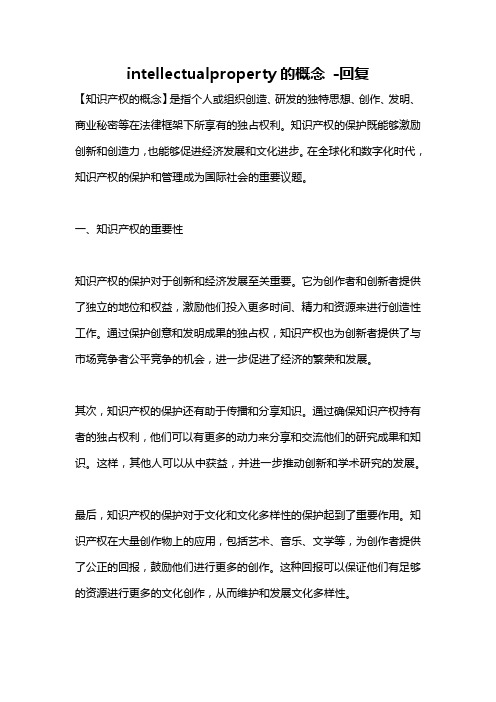
intellectualproperty的概念-回复【知识产权的概念】是指个人或组织创造、研发的独特思想、创作、发明、商业秘密等在法律框架下所享有的独占权利。
知识产权的保护既能够激励创新和创造力,也能够促进经济发展和文化进步。
在全球化和数字化时代,知识产权的保护和管理成为国际社会的重要议题。
一、知识产权的重要性知识产权的保护对于创新和经济发展至关重要。
它为创作者和创新者提供了独立的地位和权益,激励他们投入更多时间、精力和资源来进行创造性工作。
通过保护创意和发明成果的独占权,知识产权也为创新者提供了与市场竞争者公平竞争的机会,进一步促进了经济的繁荣和发展。
其次,知识产权的保护还有助于传播和分享知识。
通过确保知识产权持有者的独占权利,他们可以有更多的动力来分享和交流他们的研究成果和知识。
这样,其他人可以从中获益,并进一步推动创新和学术研究的发展。
最后,知识产权的保护对于文化和文化多样性的保护起到了重要作用。
知识产权在大量创作物上的应用,包括艺术、音乐、文学等,为创作者提供了公正的回报,鼓励他们进行更多的创作。
这种回报可以保证他们有足够的资源进行更多的文化创作,从而维护和发展文化多样性。
二、知识产权的类型知识产权通常分为五类:专利权、商标权、著作权、商业秘密和地理标志。
1. 专利权:专利权是对发明的独占权利。
它授予专利持有者在一定时间内对其发明进行独占经营的权利,以确保他们能够从中获得经济利益。
这鼓励了科学研究和技术创新,并推动了技术进步。
2. 商标权:商标权是对商标的独占使用权。
商标是区分产品或服务来源的标识,通过保护商标权,可以确保企业的品牌形象和市场地位,并防止他人未经授权使用商标。
3. 著作权:著作权是对文学、艺术作品的独占权利。
它涵盖了文学、音乐、绘画、雕塑、电影等各种艺术形式,保护了作者的创作成果,防止其他人在未经授权的情况下使用他们的作品。
4. 商业秘密:商业秘密是与商业活动相关的机密信息,例如技术、制造方法、销售策略等。
研发创新对专利的启示英语作文
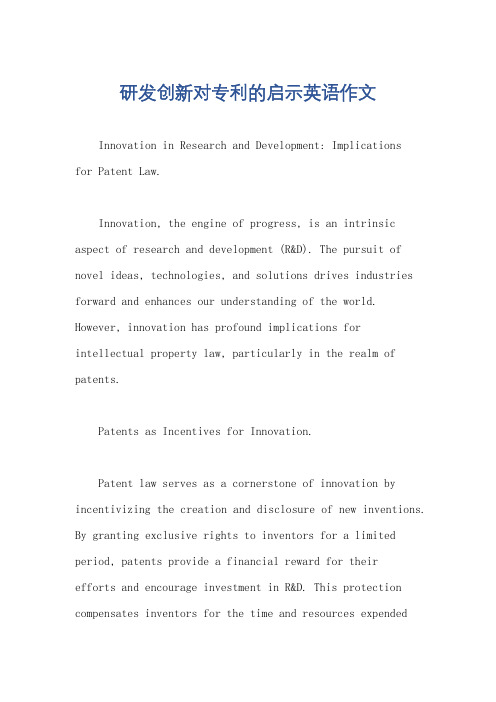
研发创新对专利的启示英语作文Innovation in Research and Development: Implicationsfor Patent Law.Innovation, the engine of progress, is an intrinsic aspect of research and development (R&D). The pursuit of novel ideas, technologies, and solutions drives industries forward and enhances our understanding of the world. However, innovation has profound implications forintellectual property law, particularly in the realm of patents.Patents as Incentives for Innovation.Patent law serves as a cornerstone of innovation by incentivizing the creation and disclosure of new inventions. By granting exclusive rights to inventors for a limited period, patents provide a financial reward for theirefforts and encourage investment in R&D. This protection compensates inventors for the time and resources expendedin developing their innovations and allows them to recoup their costs. Additionally, patents provide a clearincentive for individuals and companies to disclose their inventions to the public, expanding the collective knowledge base and fostering further advancements.Innovation and the Patent Landscape.The dynamic nature of innovation presents challenges to the patent system. As technology evolves at an unprecedented pace, new inventions and discoveries emerge continuously. This rapid innovation can outpace the capabilities of the patent system, which operates on a relatively slow and rigid timeline. The length of time required to obtain a patent can diminish its value as technology becomes obsolete. Moreover, the complexity of modern inventions often makes it difficult to define clear and narrow claims that accurately capture the scope of an invention.Rethinking the Patent System.To address the challenges posed by innovation, the patent system must evolve to accommodate the rapidly changing technological landscape. This requires a comprehensive reevaluation of existing practices and an exploration of new approaches that foster innovation while maintaining the integrity of the system.Streamlining Patent Examination.One area of improvement lies in streamlining the patent examination process. By reducing the time it takes to obtain a patent, the system can better keep pace with the rapid pace of innovation. This may involve the implementation of artificial intelligence (AI) and other advanced technologies to automate certain aspects of the examination process, allowing examiners to focus on more complex and novel inventions.Broader Claim Interpretation.Another consideration is the interpretation of patent claims. By adopting a more expansive approach to claiminterpretation, the patent system can better protect the full scope of an invention, even as it evolves over time. This requires a balancing act between providing inventors with sufficient protection while preventing overbroad claims that stifle innovation by blocking the development of related technologies.Alternative Protection Mechanisms.Beyond traditional patents, it may be necessary to explore alternative mechanisms for protecting intellectual property in the context of innovation. These mechanisms could include trade secrets, design patents, or even new forms of intellectual property protection tailored to specific industries or technologies. By providing a range of options, the system can cater to the diverse needs of innovators and ensure that all types of inventions are adequately protected.Balancing Protection and Innovation.The key challenge in patent law is to achieve adelicate balance between protecting inventors and fostering innovation. Too much protection can stifle competition and hinder the development of new technologies. Conversely, too little protection can undermine the incentive for innovation and lead to the loss of valuable inventions.Conclusion.Innovation is the lifeblood of progress and economic growth. Patent law plays a crucial role in supporting innovation by providing incentives, protecting intellectual property, and stimulating the flow of new ideas. As innovation continues to accelerate, the patent system must adapt to meet these challenges by streamlining processes, broadening claim interpretation, and exploring alternative protection mechanisms. By embracing these changes, we can ensure that the patent system remains an effective tool for protecting and fostering innovation, driving the advancement of knowledge and the betterment of society.。
